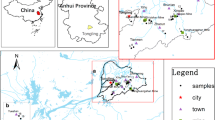Abstract
The presence of Eriophorum angustifolium in mine tailings of pyrite maintains a neutral pH, despite weathering, thus lowering the release of toxic elements into acid mine drainage water. We investigated if the presence of slightly elevated levels of free toxic elements triggers the plant rhizosphere to change the pH towards neutral by increasing organic acid contents. Plants were treated with a combination of As, Pb, Cu, Cd, and Zn at different concentrations in nutrient medium and in soil in a rhizobox-like system for 48–120 h. The pH and organic acids were detected in the mucilage dissolved from root surface, reflecting the rhizospheric solution. Also the pH of root–cell apoplasm was investigated. Both apoplasmic and mucilage pH increased and the concentrations of organic acids enhanced in the mucilage with slightly elevated levels of toxic elements. When organic acids concentration was high, also the pH was high. Thus, efflux of organic acids from the roots of E. angustifolium may induce rhizosphere basification.

Similar content being viewed by others
References
Blossfeld S, Perriguey J, Sterckeman T, Morel J-L, Lösch R (2010) Rhizosphere pH dynamics in trace-metal-contaminated soils monitored with planar pH optodes. Plant Soil 330:173–184
Bravin MN, Tentscher P, Rose J, Hinsinger P (2009) Rhizosphere pH gradient controls copper availability in a strongly acidic soil. Environ Sci Technol 43:5686–5691
Curtin D, Wen G (2004) Plant cation-anion balance as affected by the ionic composition of the growing medium. Plant Soil 267:109–115
Geilfus CM, Mühling KH (2011) Real-time imaging of leaf apoplastic pH dynamics in response to NaCl stress. Front Plant Sci 2:1–11
Greger M (2005) Influence of willow (Salix viminalis L.) roots on soil metal chemistry: effects of clones with varying metal uptake potential. In: Huang PM, Gobran G (eds) Biogeochemistry of trace elements in the rhizosphere. Elsevier, Amsterdam, pp 301–312
Grime JP, Hodgson JG, Hunt R (1988) Comparative plant ecology—a functional approach to common British species. Oxford Univ, Press, Oxford
Haoliang L, Chongling Y, Jingchun L (2007) Low-molecular-weight organic acids exuded by Mangrove (Kandelia candel L.) roots and their effect on cadmium species change in the rhizosphere. Environ Exp Bot 61:159–166
Haruta M, Constabel CP (2003) Rapid alkalinization factors in poplar cell cultures. peptide isolation, cDNA cloning, and differential expression in leaves and methyl jasmonate-treated cells. Plant Physiol 131:814–823
Hinsinger P, Plassard C, Jaillard B (2006) Rhizosphere: a new frontier for soil biogeochemistry. J Geochem Explor 88:210–213
Janicka-Russak M, Kabala K, Burzynski M, Klobus G (2008) Response of plasma membrane H+-ATPase to heavy metal stress in Cucumis sativus root. J Exp Bot 59:3721–3728
Kochian LV, Hoekenga OA, Pineros MA (2004) How do crop plants tolerate acid soils? Mechanisms of aluminum tolerance and phosphorus efficiency. Annu Rev Plant Biol 55:459–493
Lindberg S, Landberg T, Greger M (2004) A new method to detect cadmium uptake in protoplasts. Planta 219:526–532
Lindberg S, Wingstrand G (1985) Mechanism for Cd2+ inhibition of (K++ Mg2+)ATPase activity and K+(86Rb+) uptake in roots of sugar beet (Beta vulgaris). Physiol Plant 63:181–185
Ma JF, Taketa S, Yang ZM (2000) Aluminium tolerance genes on the short arm of chromosome 3R are linked to organic acid release in triticale. Plant Physiol 122:687–694
Mayer WJ, McCarthy JP, Greenberg MS (1979) The determination of oxalic acid in urine by high performance liquid chromatography with electrochemical detection. J Chromatogr Sci 17:656–660
Otte ML, Matthews DJ, Jacob DL, Moran BM, Baker AJM (2004) Biogeochemistry of metals in the rhizosphere of wetland plants—an explanation for innate metal tolerance? In: Wong MH (ed) Wetland ecosystems in Asia: function, usage and management, developments in ecosystems 1. Elsevier, Amsterdam, pp 87–94
Pearce G, Moura DS, Stratmann J, Ryan CA (2001) RALF, a 5-kDa ubiquitous polypeptide in plants, arrests root growth and development. Proc Natl Acad Sci USA 98:12843–12847
Qin R, Hirano Y, Brunner I (2007) Exudation of organic acid anions from poplar roots after exposure to Al, Cu and Zn. Tree Physiol 27:313–320
Song FQ, Yang GT, Meng FR, Tian XJ, Dong AR (2004) The rhizospheric niche of seedlings of Populus ussuriensis colonized by arbuscular mycorrhizal (AM) fungi. Ecol Environ 13:211–216
Stoltz E, Greger M (2002) Cottongrass effects of trace elements in submersed mine tailings. J Environ Qual 31:1477–1483
Stoltz E, Greger M (2006) Release of metals and arsenic from various mine tailings by Eriophorum angustifolium. Plant Soil 289:199–210
VanLoon GW, Duffy SJ (2000) Environmental chemistry—a global perspective. Oxford University Press, New York, pp 366–385
Vylkova S, Carman AJ, Danhof HA, Collette JR, Zhou HJ, Lorenz MC (2011) The fungal pathogen Candida albicans autoinduces hyphal morphogenesis by raising extracellular pH. mBio 2:e00055. doi:10.1128/mBio.00055-11
Wang AS, Angle JS, Rufus LC, Delorme TA, Reeves RD (2006) Soil pH effects on uptake of Cd and Zn by Thlaspi caerulencens. Plant Soil 281:325–337
Wheeler JI, Irving HR (2010) Evolutionary advantages of secreted peptide signalling molecules in plant. Funct Plant Biol 37:382–394
Zeng F, Chen S, Miao Y, Wu F, Zhang G (2008) Changes of organic acid exudation and rhizosphere pH in rice plant under chromium stress. Environ Pollut 155:284–289
Zhao Z, Ma JF, Sato K, Takeda K (2003) Different Al resistance and citrate secretion in barley (Hordeum vulgare L.). Planta 217:794–800
Acknowledgments
The authors acknowledge the Carl Tryggers and the Knut and Alice Wallenberg Foundations of Sweden and Higher Education Commission of Pakistan for financial support. We also thank Claes Bergqvist for collecting E. angustifolium seeds.
Author information
Authors and Affiliations
Corresponding author
Additional information
Responsible editor: Philippe Garrigues
Rights and permissions
About this article
Cite this article
Javed, M.T., Stoltz, E., Lindberg, S. et al. Changes in pH and organic acids in mucilage of Eriophorum angustifolium roots after exposure to elevated concentrations of toxic elements. Environ Sci Pollut Res 20, 1876–1880 (2013). https://doi.org/10.1007/s11356-012-1413-z
Received:
Accepted:
Published:
Issue Date:
DOI: https://doi.org/10.1007/s11356-012-1413-z




